Analysis of HIV/AIDS Patient Care Using Corbin and Strauss Model
VerifiedAdded on 2022/12/29
|8
|2751
|38
Report
AI Summary
This report analyzes a case study of a patient diagnosed with HIV/AIDS, focusing on the application of the Corbin and Strauss Illness Trajectory Model and the socio-ecological framework to develop a comprehensive care plan. The report begins with an introduction to the challenges of living with a progressive illness and then discusses the illness trajectory model, identifying the patient's current phase and outlining appropriate nursing interventions. It also examines the socio-ecological framework, addressing the patient's primary healthcare needs across individual, interpersonal, community, organizational, and policy levels. The report emphasizes patient-centered care, the importance of social support, community resources, and organizational support services. The assignment also highlights the significance of equipment and services, including government support for HIV/AIDS patients. The conclusion summarizes the key findings and the importance of holistic care for patients with HIV/AIDS.
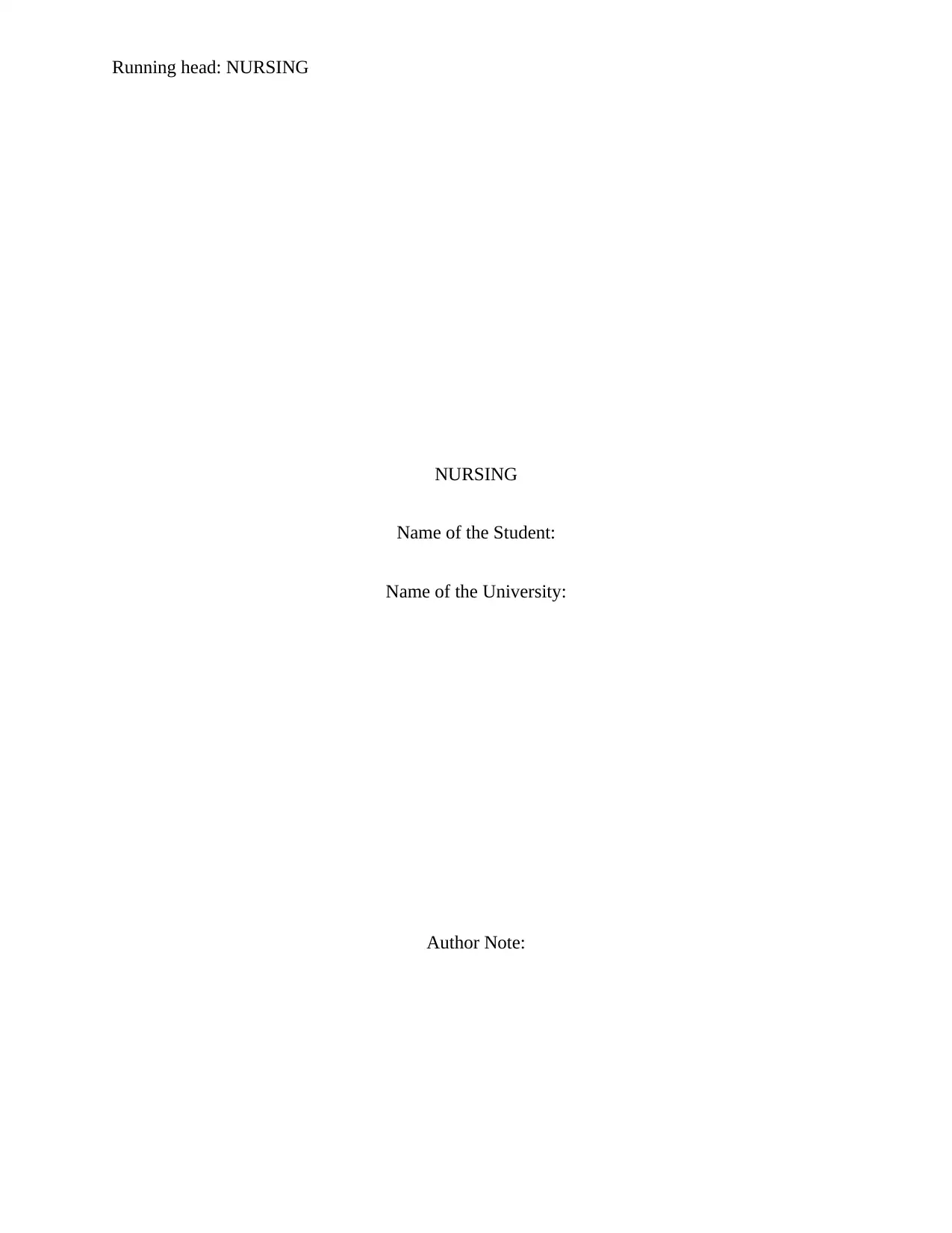
Running head: NURSING
NURSING
Name of the Student:
Name of the University:
Author Note:
NURSING
Name of the Student:
Name of the University:
Author Note:
Paraphrase This Document
Need a fresh take? Get an instant paraphrase of this document with our AI Paraphraser
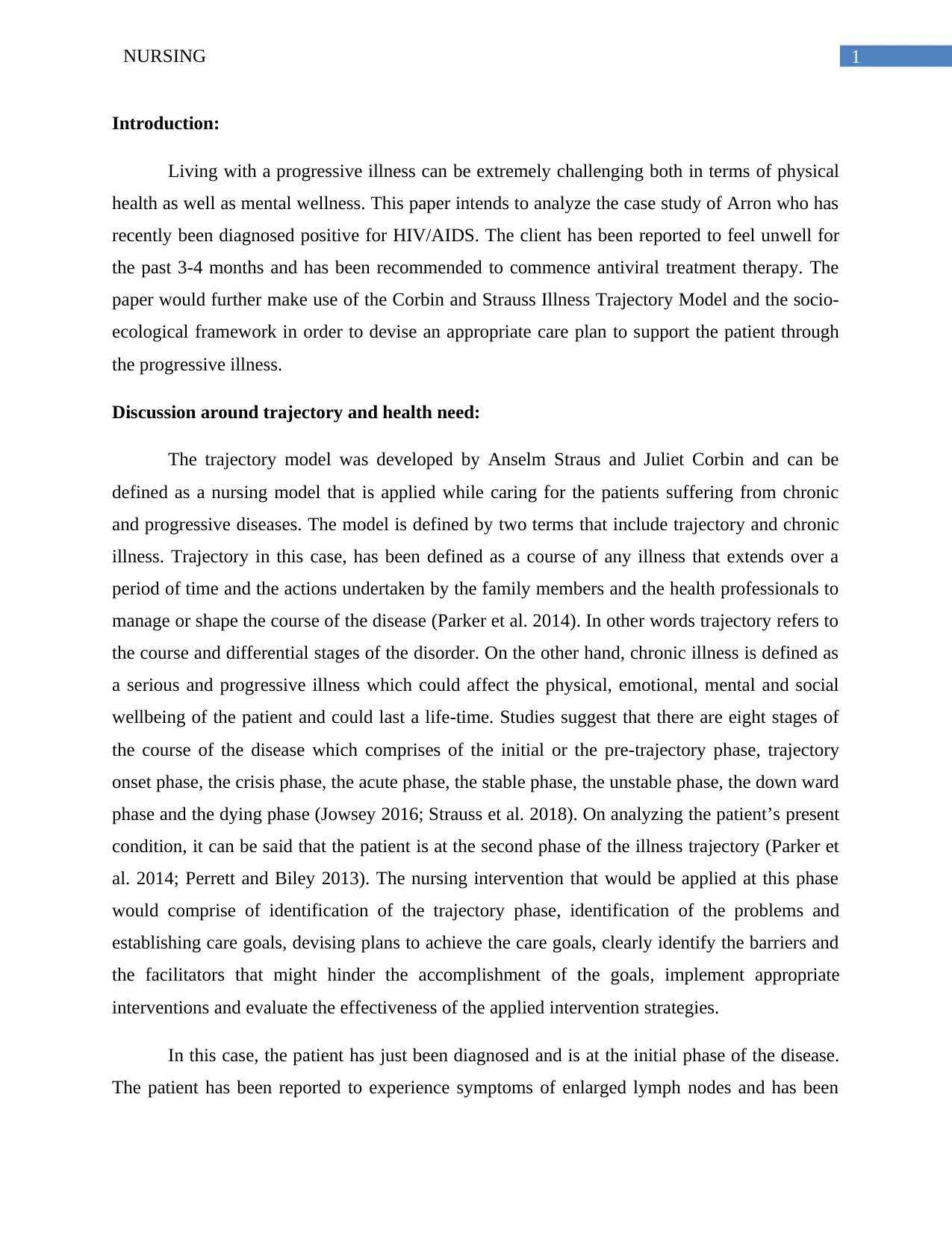
1NURSING
Introduction:
Living with a progressive illness can be extremely challenging both in terms of physical
health as well as mental wellness. This paper intends to analyze the case study of Arron who has
recently been diagnosed positive for HIV/AIDS. The client has been reported to feel unwell for
the past 3-4 months and has been recommended to commence antiviral treatment therapy. The
paper would further make use of the Corbin and Strauss Illness Trajectory Model and the socio-
ecological framework in order to devise an appropriate care plan to support the patient through
the progressive illness.
Discussion around trajectory and health need:
The trajectory model was developed by Anselm Straus and Juliet Corbin and can be
defined as a nursing model that is applied while caring for the patients suffering from chronic
and progressive diseases. The model is defined by two terms that include trajectory and chronic
illness. Trajectory in this case, has been defined as a course of any illness that extends over a
period of time and the actions undertaken by the family members and the health professionals to
manage or shape the course of the disease (Parker et al. 2014). In other words trajectory refers to
the course and differential stages of the disorder. On the other hand, chronic illness is defined as
a serious and progressive illness which could affect the physical, emotional, mental and social
wellbeing of the patient and could last a life-time. Studies suggest that there are eight stages of
the course of the disease which comprises of the initial or the pre-trajectory phase, trajectory
onset phase, the crisis phase, the acute phase, the stable phase, the unstable phase, the down ward
phase and the dying phase (Jowsey 2016; Strauss et al. 2018). On analyzing the patient’s present
condition, it can be said that the patient is at the second phase of the illness trajectory (Parker et
al. 2014; Perrett and Biley 2013). The nursing intervention that would be applied at this phase
would comprise of identification of the trajectory phase, identification of the problems and
establishing care goals, devising plans to achieve the care goals, clearly identify the barriers and
the facilitators that might hinder the accomplishment of the goals, implement appropriate
interventions and evaluate the effectiveness of the applied intervention strategies.
In this case, the patient has just been diagnosed and is at the initial phase of the disease.
The patient has been reported to experience symptoms of enlarged lymph nodes and has been
Introduction:
Living with a progressive illness can be extremely challenging both in terms of physical
health as well as mental wellness. This paper intends to analyze the case study of Arron who has
recently been diagnosed positive for HIV/AIDS. The client has been reported to feel unwell for
the past 3-4 months and has been recommended to commence antiviral treatment therapy. The
paper would further make use of the Corbin and Strauss Illness Trajectory Model and the socio-
ecological framework in order to devise an appropriate care plan to support the patient through
the progressive illness.
Discussion around trajectory and health need:
The trajectory model was developed by Anselm Straus and Juliet Corbin and can be
defined as a nursing model that is applied while caring for the patients suffering from chronic
and progressive diseases. The model is defined by two terms that include trajectory and chronic
illness. Trajectory in this case, has been defined as a course of any illness that extends over a
period of time and the actions undertaken by the family members and the health professionals to
manage or shape the course of the disease (Parker et al. 2014). In other words trajectory refers to
the course and differential stages of the disorder. On the other hand, chronic illness is defined as
a serious and progressive illness which could affect the physical, emotional, mental and social
wellbeing of the patient and could last a life-time. Studies suggest that there are eight stages of
the course of the disease which comprises of the initial or the pre-trajectory phase, trajectory
onset phase, the crisis phase, the acute phase, the stable phase, the unstable phase, the down ward
phase and the dying phase (Jowsey 2016; Strauss et al. 2018). On analyzing the patient’s present
condition, it can be said that the patient is at the second phase of the illness trajectory (Parker et
al. 2014; Perrett and Biley 2013). The nursing intervention that would be applied at this phase
would comprise of identification of the trajectory phase, identification of the problems and
establishing care goals, devising plans to achieve the care goals, clearly identify the barriers and
the facilitators that might hinder the accomplishment of the goals, implement appropriate
interventions and evaluate the effectiveness of the applied intervention strategies.
In this case, the patient has just been diagnosed and is at the initial phase of the disease.
The patient has been reported to experience symptoms of enlarged lymph nodes and has been
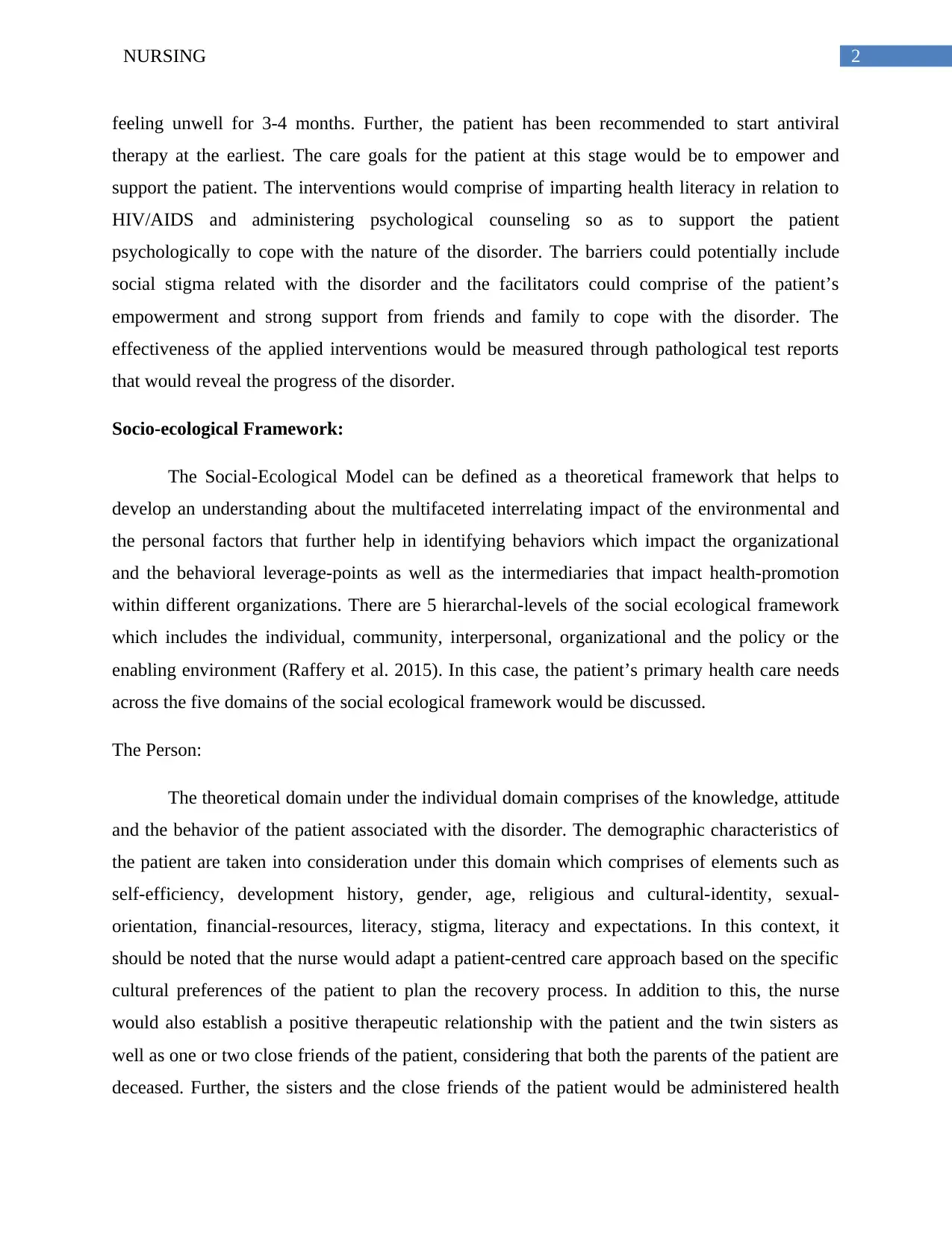
2NURSING
feeling unwell for 3-4 months. Further, the patient has been recommended to start antiviral
therapy at the earliest. The care goals for the patient at this stage would be to empower and
support the patient. The interventions would comprise of imparting health literacy in relation to
HIV/AIDS and administering psychological counseling so as to support the patient
psychologically to cope with the nature of the disorder. The barriers could potentially include
social stigma related with the disorder and the facilitators could comprise of the patient’s
empowerment and strong support from friends and family to cope with the disorder. The
effectiveness of the applied interventions would be measured through pathological test reports
that would reveal the progress of the disorder.
Socio-ecological Framework:
The Social-Ecological Model can be defined as a theoretical framework that helps to
develop an understanding about the multifaceted interrelating impact of the environmental and
the personal factors that further help in identifying behaviors which impact the organizational
and the behavioral leverage-points as well as the intermediaries that impact health-promotion
within different organizations. There are 5 hierarchal-levels of the social ecological framework
which includes the individual, community, interpersonal, organizational and the policy or the
enabling environment (Raffery et al. 2015). In this case, the patient’s primary health care needs
across the five domains of the social ecological framework would be discussed.
The Person:
The theoretical domain under the individual domain comprises of the knowledge, attitude
and the behavior of the patient associated with the disorder. The demographic characteristics of
the patient are taken into consideration under this domain which comprises of elements such as
self-efficiency, development history, gender, age, religious and cultural-identity, sexual-
orientation, financial-resources, literacy, stigma, literacy and expectations. In this context, it
should be noted that the nurse would adapt a patient-centred care approach based on the specific
cultural preferences of the patient to plan the recovery process. In addition to this, the nurse
would also establish a positive therapeutic relationship with the patient and the twin sisters as
well as one or two close friends of the patient, considering that both the parents of the patient are
deceased. Further, the sisters and the close friends of the patient would be administered health
feeling unwell for 3-4 months. Further, the patient has been recommended to start antiviral
therapy at the earliest. The care goals for the patient at this stage would be to empower and
support the patient. The interventions would comprise of imparting health literacy in relation to
HIV/AIDS and administering psychological counseling so as to support the patient
psychologically to cope with the nature of the disorder. The barriers could potentially include
social stigma related with the disorder and the facilitators could comprise of the patient’s
empowerment and strong support from friends and family to cope with the disorder. The
effectiveness of the applied interventions would be measured through pathological test reports
that would reveal the progress of the disorder.
Socio-ecological Framework:
The Social-Ecological Model can be defined as a theoretical framework that helps to
develop an understanding about the multifaceted interrelating impact of the environmental and
the personal factors that further help in identifying behaviors which impact the organizational
and the behavioral leverage-points as well as the intermediaries that impact health-promotion
within different organizations. There are 5 hierarchal-levels of the social ecological framework
which includes the individual, community, interpersonal, organizational and the policy or the
enabling environment (Raffery et al. 2015). In this case, the patient’s primary health care needs
across the five domains of the social ecological framework would be discussed.
The Person:
The theoretical domain under the individual domain comprises of the knowledge, attitude
and the behavior of the patient associated with the disorder. The demographic characteristics of
the patient are taken into consideration under this domain which comprises of elements such as
self-efficiency, development history, gender, age, religious and cultural-identity, sexual-
orientation, financial-resources, literacy, stigma, literacy and expectations. In this context, it
should be noted that the nurse would adapt a patient-centred care approach based on the specific
cultural preferences of the patient to plan the recovery process. In addition to this, the nurse
would also establish a positive therapeutic relationship with the patient and the twin sisters as
well as one or two close friends of the patient, considering that both the parents of the patient are
deceased. Further, the sisters and the close friends of the patient would be administered health
⊘ This is a preview!⊘
Do you want full access?
Subscribe today to unlock all pages.

Trusted by 1+ million students worldwide
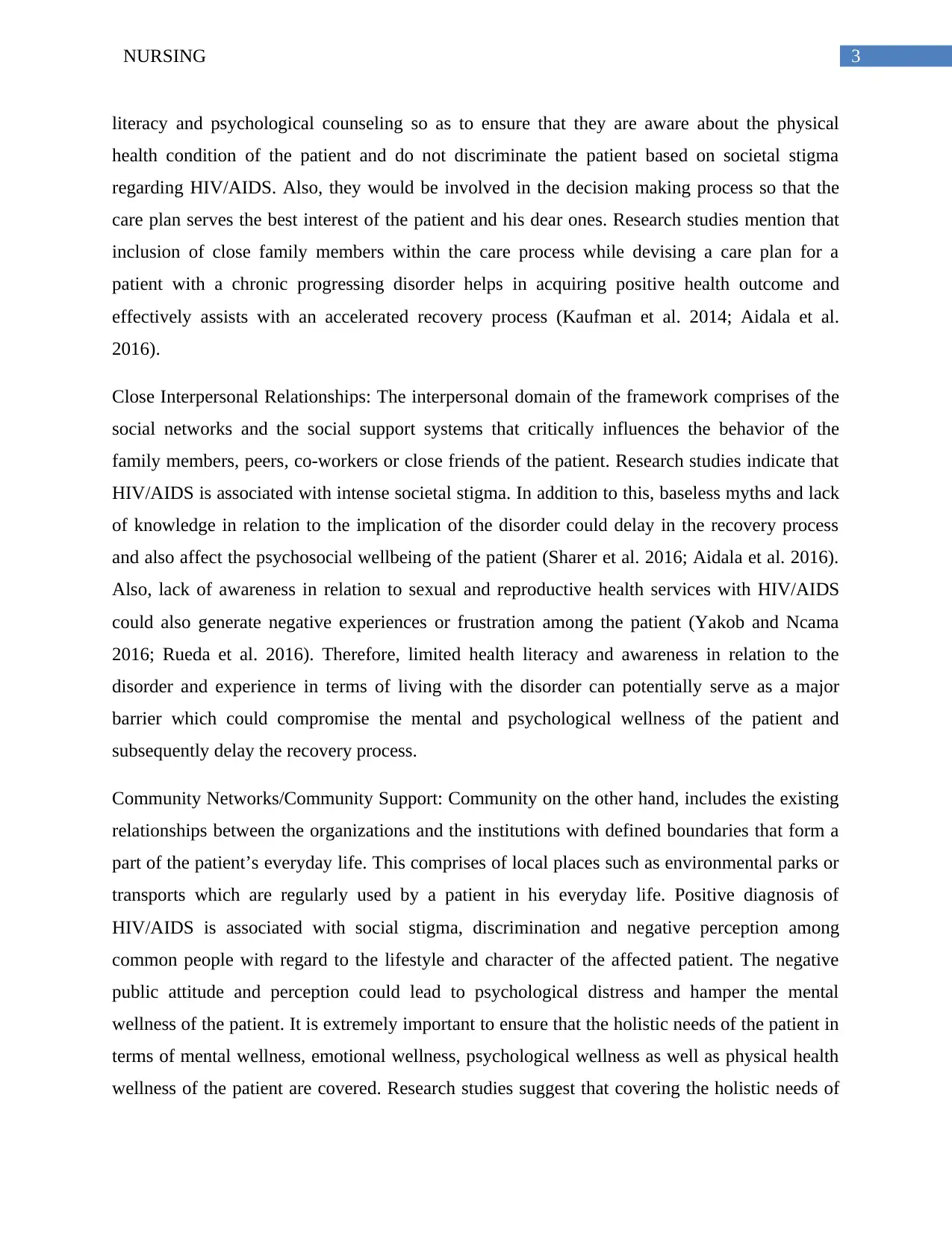
3NURSING
literacy and psychological counseling so as to ensure that they are aware about the physical
health condition of the patient and do not discriminate the patient based on societal stigma
regarding HIV/AIDS. Also, they would be involved in the decision making process so that the
care plan serves the best interest of the patient and his dear ones. Research studies mention that
inclusion of close family members within the care process while devising a care plan for a
patient with a chronic progressing disorder helps in acquiring positive health outcome and
effectively assists with an accelerated recovery process (Kaufman et al. 2014; Aidala et al.
2016).
Close Interpersonal Relationships: The interpersonal domain of the framework comprises of the
social networks and the social support systems that critically influences the behavior of the
family members, peers, co-workers or close friends of the patient. Research studies indicate that
HIV/AIDS is associated with intense societal stigma. In addition to this, baseless myths and lack
of knowledge in relation to the implication of the disorder could delay in the recovery process
and also affect the psychosocial wellbeing of the patient (Sharer et al. 2016; Aidala et al. 2016).
Also, lack of awareness in relation to sexual and reproductive health services with HIV/AIDS
could also generate negative experiences or frustration among the patient (Yakob and Ncama
2016; Rueda et al. 2016). Therefore, limited health literacy and awareness in relation to the
disorder and experience in terms of living with the disorder can potentially serve as a major
barrier which could compromise the mental and psychological wellness of the patient and
subsequently delay the recovery process.
Community Networks/Community Support: Community on the other hand, includes the existing
relationships between the organizations and the institutions with defined boundaries that form a
part of the patient’s everyday life. This comprises of local places such as environmental parks or
transports which are regularly used by a patient in his everyday life. Positive diagnosis of
HIV/AIDS is associated with social stigma, discrimination and negative perception among
common people with regard to the lifestyle and character of the affected patient. The negative
public attitude and perception could lead to psychological distress and hamper the mental
wellness of the patient. It is extremely important to ensure that the holistic needs of the patient in
terms of mental wellness, emotional wellness, psychological wellness as well as physical health
wellness of the patient are covered. Research studies suggest that covering the holistic needs of
literacy and psychological counseling so as to ensure that they are aware about the physical
health condition of the patient and do not discriminate the patient based on societal stigma
regarding HIV/AIDS. Also, they would be involved in the decision making process so that the
care plan serves the best interest of the patient and his dear ones. Research studies mention that
inclusion of close family members within the care process while devising a care plan for a
patient with a chronic progressing disorder helps in acquiring positive health outcome and
effectively assists with an accelerated recovery process (Kaufman et al. 2014; Aidala et al.
2016).
Close Interpersonal Relationships: The interpersonal domain of the framework comprises of the
social networks and the social support systems that critically influences the behavior of the
family members, peers, co-workers or close friends of the patient. Research studies indicate that
HIV/AIDS is associated with intense societal stigma. In addition to this, baseless myths and lack
of knowledge in relation to the implication of the disorder could delay in the recovery process
and also affect the psychosocial wellbeing of the patient (Sharer et al. 2016; Aidala et al. 2016).
Also, lack of awareness in relation to sexual and reproductive health services with HIV/AIDS
could also generate negative experiences or frustration among the patient (Yakob and Ncama
2016; Rueda et al. 2016). Therefore, limited health literacy and awareness in relation to the
disorder and experience in terms of living with the disorder can potentially serve as a major
barrier which could compromise the mental and psychological wellness of the patient and
subsequently delay the recovery process.
Community Networks/Community Support: Community on the other hand, includes the existing
relationships between the organizations and the institutions with defined boundaries that form a
part of the patient’s everyday life. This comprises of local places such as environmental parks or
transports which are regularly used by a patient in his everyday life. Positive diagnosis of
HIV/AIDS is associated with social stigma, discrimination and negative perception among
common people with regard to the lifestyle and character of the affected patient. The negative
public attitude and perception could lead to psychological distress and hamper the mental
wellness of the patient. It is extremely important to ensure that the holistic needs of the patient in
terms of mental wellness, emotional wellness, psychological wellness as well as physical health
wellness of the patient are covered. Research studies suggest that covering the holistic needs of
Paraphrase This Document
Need a fresh take? Get an instant paraphrase of this document with our AI Paraphraser
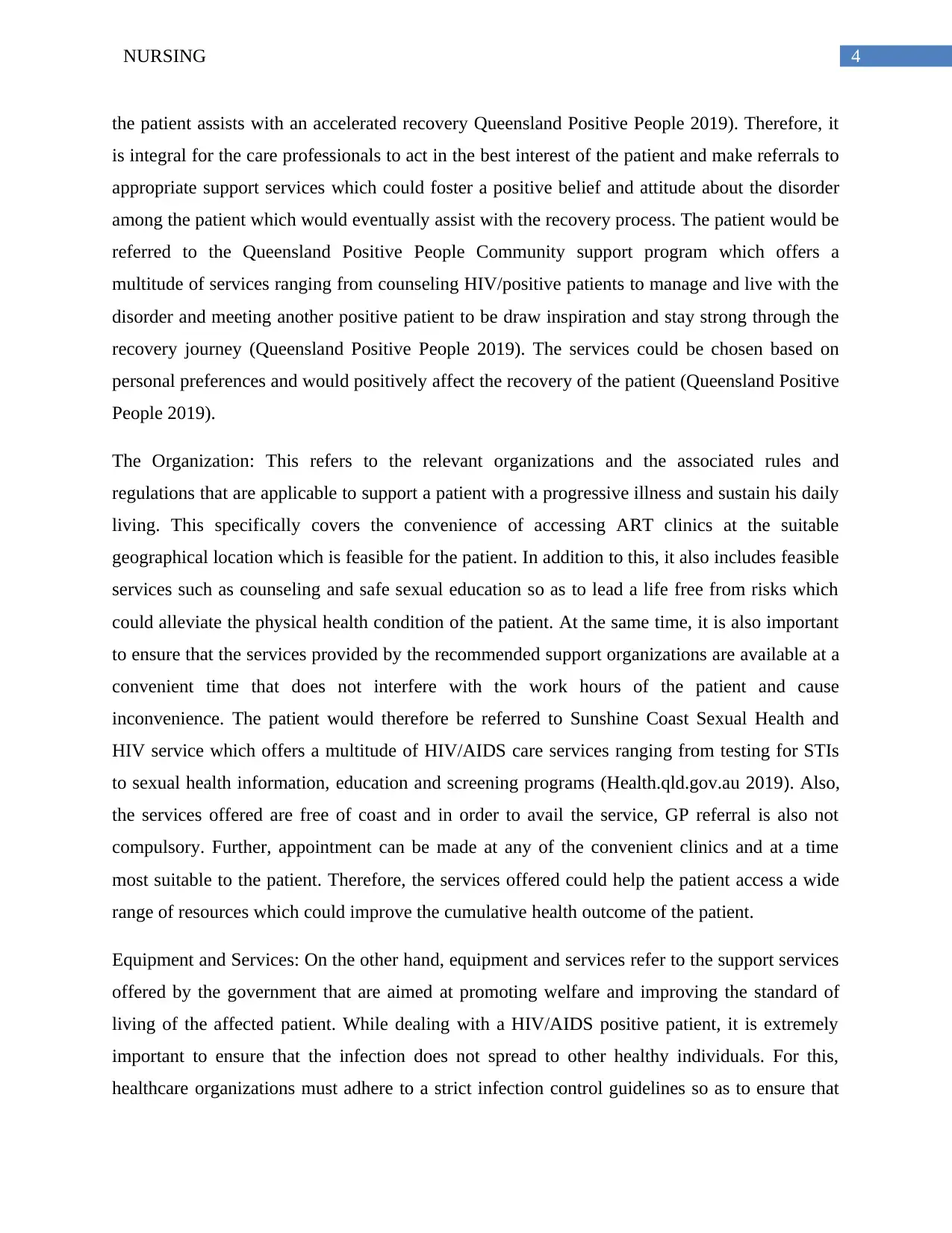
4NURSING
the patient assists with an accelerated recovery Queensland Positive People 2019). Therefore, it
is integral for the care professionals to act in the best interest of the patient and make referrals to
appropriate support services which could foster a positive belief and attitude about the disorder
among the patient which would eventually assist with the recovery process. The patient would be
referred to the Queensland Positive People Community support program which offers a
multitude of services ranging from counseling HIV/positive patients to manage and live with the
disorder and meeting another positive patient to be draw inspiration and stay strong through the
recovery journey (Queensland Positive People 2019). The services could be chosen based on
personal preferences and would positively affect the recovery of the patient (Queensland Positive
People 2019).
The Organization: This refers to the relevant organizations and the associated rules and
regulations that are applicable to support a patient with a progressive illness and sustain his daily
living. This specifically covers the convenience of accessing ART clinics at the suitable
geographical location which is feasible for the patient. In addition to this, it also includes feasible
services such as counseling and safe sexual education so as to lead a life free from risks which
could alleviate the physical health condition of the patient. At the same time, it is also important
to ensure that the services provided by the recommended support organizations are available at a
convenient time that does not interfere with the work hours of the patient and cause
inconvenience. The patient would therefore be referred to Sunshine Coast Sexual Health and
HIV service which offers a multitude of HIV/AIDS care services ranging from testing for STIs
to sexual health information, education and screening programs (Health.qld.gov.au 2019). Also,
the services offered are free of coast and in order to avail the service, GP referral is also not
compulsory. Further, appointment can be made at any of the convenient clinics and at a time
most suitable to the patient. Therefore, the services offered could help the patient access a wide
range of resources which could improve the cumulative health outcome of the patient.
Equipment and Services: On the other hand, equipment and services refer to the support services
offered by the government that are aimed at promoting welfare and improving the standard of
living of the affected patient. While dealing with a HIV/AIDS positive patient, it is extremely
important to ensure that the infection does not spread to other healthy individuals. For this,
healthcare organizations must adhere to a strict infection control guidelines so as to ensure that
the patient assists with an accelerated recovery Queensland Positive People 2019). Therefore, it
is integral for the care professionals to act in the best interest of the patient and make referrals to
appropriate support services which could foster a positive belief and attitude about the disorder
among the patient which would eventually assist with the recovery process. The patient would be
referred to the Queensland Positive People Community support program which offers a
multitude of services ranging from counseling HIV/positive patients to manage and live with the
disorder and meeting another positive patient to be draw inspiration and stay strong through the
recovery journey (Queensland Positive People 2019). The services could be chosen based on
personal preferences and would positively affect the recovery of the patient (Queensland Positive
People 2019).
The Organization: This refers to the relevant organizations and the associated rules and
regulations that are applicable to support a patient with a progressive illness and sustain his daily
living. This specifically covers the convenience of accessing ART clinics at the suitable
geographical location which is feasible for the patient. In addition to this, it also includes feasible
services such as counseling and safe sexual education so as to lead a life free from risks which
could alleviate the physical health condition of the patient. At the same time, it is also important
to ensure that the services provided by the recommended support organizations are available at a
convenient time that does not interfere with the work hours of the patient and cause
inconvenience. The patient would therefore be referred to Sunshine Coast Sexual Health and
HIV service which offers a multitude of HIV/AIDS care services ranging from testing for STIs
to sexual health information, education and screening programs (Health.qld.gov.au 2019). Also,
the services offered are free of coast and in order to avail the service, GP referral is also not
compulsory. Further, appointment can be made at any of the convenient clinics and at a time
most suitable to the patient. Therefore, the services offered could help the patient access a wide
range of resources which could improve the cumulative health outcome of the patient.
Equipment and Services: On the other hand, equipment and services refer to the support services
offered by the government that are aimed at promoting welfare and improving the standard of
living of the affected patient. While dealing with a HIV/AIDS positive patient, it is extremely
important to ensure that the infection does not spread to other healthy individuals. For this,
healthcare organizations must adhere to a strict infection control guidelines so as to ensure that
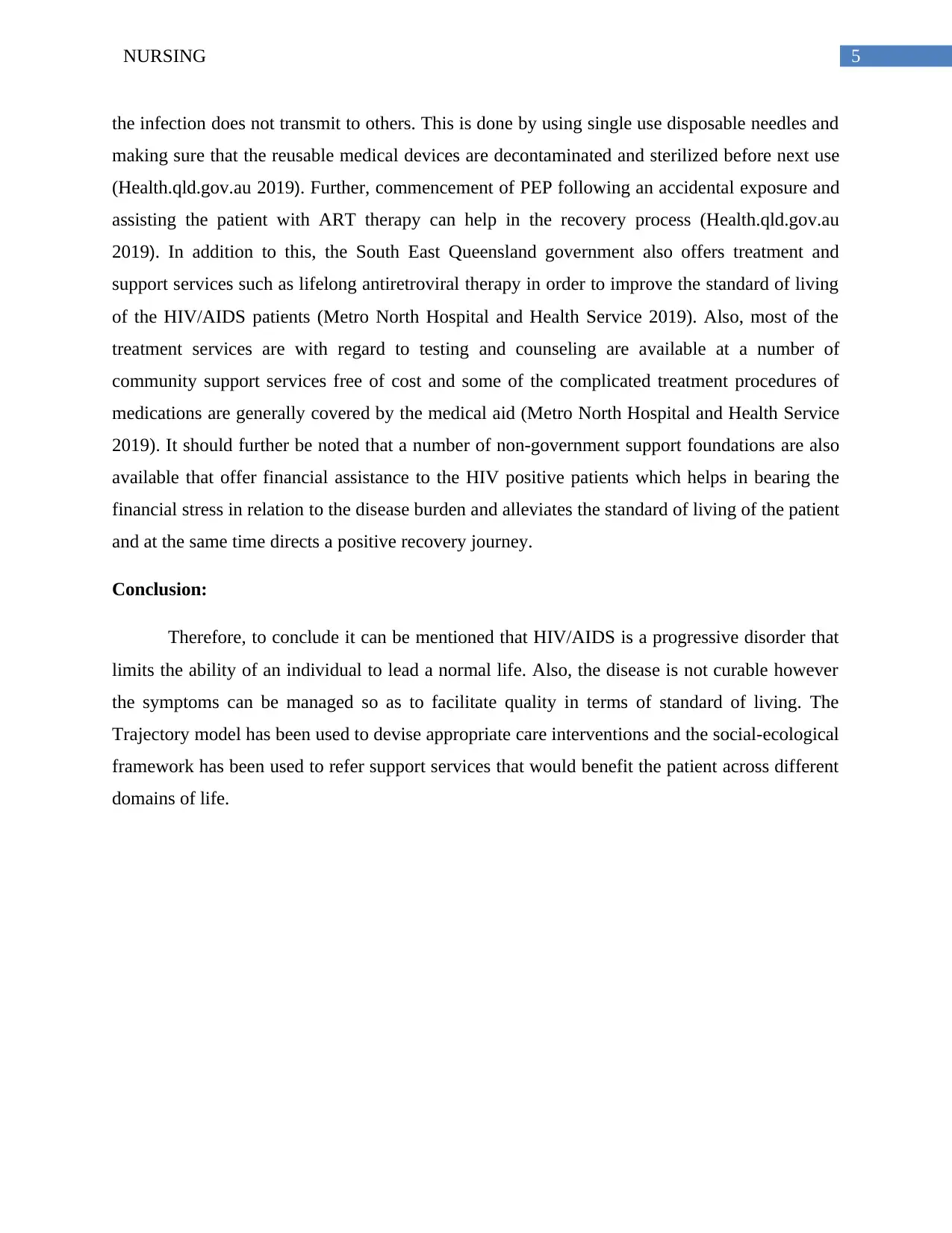
5NURSING
the infection does not transmit to others. This is done by using single use disposable needles and
making sure that the reusable medical devices are decontaminated and sterilized before next use
(Health.qld.gov.au 2019). Further, commencement of PEP following an accidental exposure and
assisting the patient with ART therapy can help in the recovery process (Health.qld.gov.au
2019). In addition to this, the South East Queensland government also offers treatment and
support services such as lifelong antiretroviral therapy in order to improve the standard of living
of the HIV/AIDS patients (Metro North Hospital and Health Service 2019). Also, most of the
treatment services are with regard to testing and counseling are available at a number of
community support services free of cost and some of the complicated treatment procedures of
medications are generally covered by the medical aid (Metro North Hospital and Health Service
2019). It should further be noted that a number of non-government support foundations are also
available that offer financial assistance to the HIV positive patients which helps in bearing the
financial stress in relation to the disease burden and alleviates the standard of living of the patient
and at the same time directs a positive recovery journey.
Conclusion:
Therefore, to conclude it can be mentioned that HIV/AIDS is a progressive disorder that
limits the ability of an individual to lead a normal life. Also, the disease is not curable however
the symptoms can be managed so as to facilitate quality in terms of standard of living. The
Trajectory model has been used to devise appropriate care interventions and the social-ecological
framework has been used to refer support services that would benefit the patient across different
domains of life.
the infection does not transmit to others. This is done by using single use disposable needles and
making sure that the reusable medical devices are decontaminated and sterilized before next use
(Health.qld.gov.au 2019). Further, commencement of PEP following an accidental exposure and
assisting the patient with ART therapy can help in the recovery process (Health.qld.gov.au
2019). In addition to this, the South East Queensland government also offers treatment and
support services such as lifelong antiretroviral therapy in order to improve the standard of living
of the HIV/AIDS patients (Metro North Hospital and Health Service 2019). Also, most of the
treatment services are with regard to testing and counseling are available at a number of
community support services free of cost and some of the complicated treatment procedures of
medications are generally covered by the medical aid (Metro North Hospital and Health Service
2019). It should further be noted that a number of non-government support foundations are also
available that offer financial assistance to the HIV positive patients which helps in bearing the
financial stress in relation to the disease burden and alleviates the standard of living of the patient
and at the same time directs a positive recovery journey.
Conclusion:
Therefore, to conclude it can be mentioned that HIV/AIDS is a progressive disorder that
limits the ability of an individual to lead a normal life. Also, the disease is not curable however
the symptoms can be managed so as to facilitate quality in terms of standard of living. The
Trajectory model has been used to devise appropriate care interventions and the social-ecological
framework has been used to refer support services that would benefit the patient across different
domains of life.
⊘ This is a preview!⊘
Do you want full access?
Subscribe today to unlock all pages.

Trusted by 1+ million students worldwide
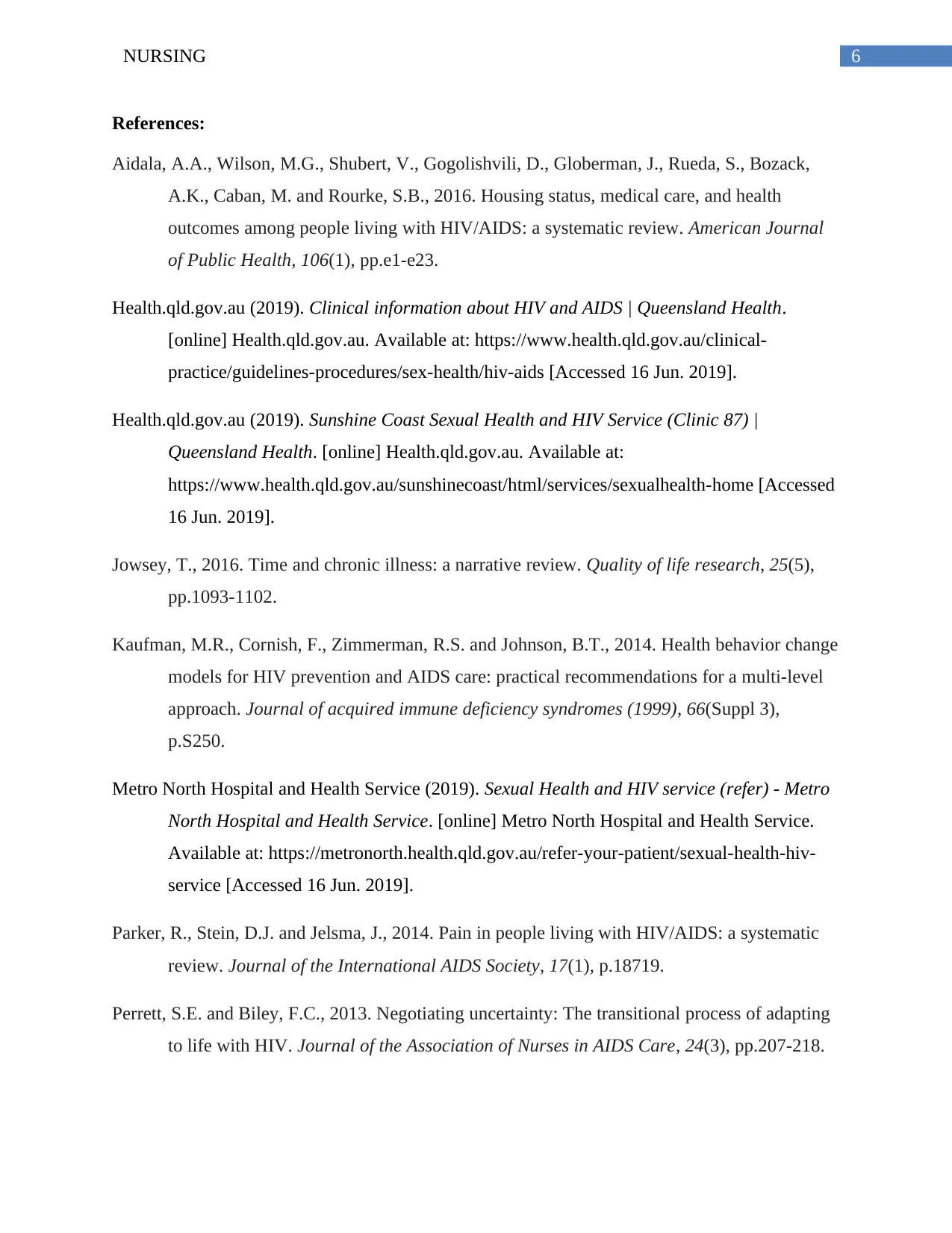
6NURSING
References:
Aidala, A.A., Wilson, M.G., Shubert, V., Gogolishvili, D., Globerman, J., Rueda, S., Bozack,
A.K., Caban, M. and Rourke, S.B., 2016. Housing status, medical care, and health
outcomes among people living with HIV/AIDS: a systematic review. American Journal
of Public Health, 106(1), pp.e1-e23.
Health.qld.gov.au (2019). Clinical information about HIV and AIDS | Queensland Health.
[online] Health.qld.gov.au. Available at: https://www.health.qld.gov.au/clinical-
practice/guidelines-procedures/sex-health/hiv-aids [Accessed 16 Jun. 2019].
Health.qld.gov.au (2019). Sunshine Coast Sexual Health and HIV Service (Clinic 87) |
Queensland Health. [online] Health.qld.gov.au. Available at:
https://www.health.qld.gov.au/sunshinecoast/html/services/sexualhealth-home [Accessed
16 Jun. 2019].
Jowsey, T., 2016. Time and chronic illness: a narrative review. Quality of life research, 25(5),
pp.1093-1102.
Kaufman, M.R., Cornish, F., Zimmerman, R.S. and Johnson, B.T., 2014. Health behavior change
models for HIV prevention and AIDS care: practical recommendations for a multi-level
approach. Journal of acquired immune deficiency syndromes (1999), 66(Suppl 3),
p.S250.
Metro North Hospital and Health Service (2019). Sexual Health and HIV service (refer) - Metro
North Hospital and Health Service. [online] Metro North Hospital and Health Service.
Available at: https://metronorth.health.qld.gov.au/refer-your-patient/sexual-health-hiv-
service [Accessed 16 Jun. 2019].
Parker, R., Stein, D.J. and Jelsma, J., 2014. Pain in people living with HIV/AIDS: a systematic
review. Journal of the International AIDS Society, 17(1), p.18719.
Perrett, S.E. and Biley, F.C., 2013. Negotiating uncertainty: The transitional process of adapting
to life with HIV. Journal of the Association of Nurses in AIDS Care, 24(3), pp.207-218.
References:
Aidala, A.A., Wilson, M.G., Shubert, V., Gogolishvili, D., Globerman, J., Rueda, S., Bozack,
A.K., Caban, M. and Rourke, S.B., 2016. Housing status, medical care, and health
outcomes among people living with HIV/AIDS: a systematic review. American Journal
of Public Health, 106(1), pp.e1-e23.
Health.qld.gov.au (2019). Clinical information about HIV and AIDS | Queensland Health.
[online] Health.qld.gov.au. Available at: https://www.health.qld.gov.au/clinical-
practice/guidelines-procedures/sex-health/hiv-aids [Accessed 16 Jun. 2019].
Health.qld.gov.au (2019). Sunshine Coast Sexual Health and HIV Service (Clinic 87) |
Queensland Health. [online] Health.qld.gov.au. Available at:
https://www.health.qld.gov.au/sunshinecoast/html/services/sexualhealth-home [Accessed
16 Jun. 2019].
Jowsey, T., 2016. Time and chronic illness: a narrative review. Quality of life research, 25(5),
pp.1093-1102.
Kaufman, M.R., Cornish, F., Zimmerman, R.S. and Johnson, B.T., 2014. Health behavior change
models for HIV prevention and AIDS care: practical recommendations for a multi-level
approach. Journal of acquired immune deficiency syndromes (1999), 66(Suppl 3),
p.S250.
Metro North Hospital and Health Service (2019). Sexual Health and HIV service (refer) - Metro
North Hospital and Health Service. [online] Metro North Hospital and Health Service.
Available at: https://metronorth.health.qld.gov.au/refer-your-patient/sexual-health-hiv-
service [Accessed 16 Jun. 2019].
Parker, R., Stein, D.J. and Jelsma, J., 2014. Pain in people living with HIV/AIDS: a systematic
review. Journal of the International AIDS Society, 17(1), p.18719.
Perrett, S.E. and Biley, F.C., 2013. Negotiating uncertainty: The transitional process of adapting
to life with HIV. Journal of the Association of Nurses in AIDS Care, 24(3), pp.207-218.
Paraphrase This Document
Need a fresh take? Get an instant paraphrase of this document with our AI Paraphraser
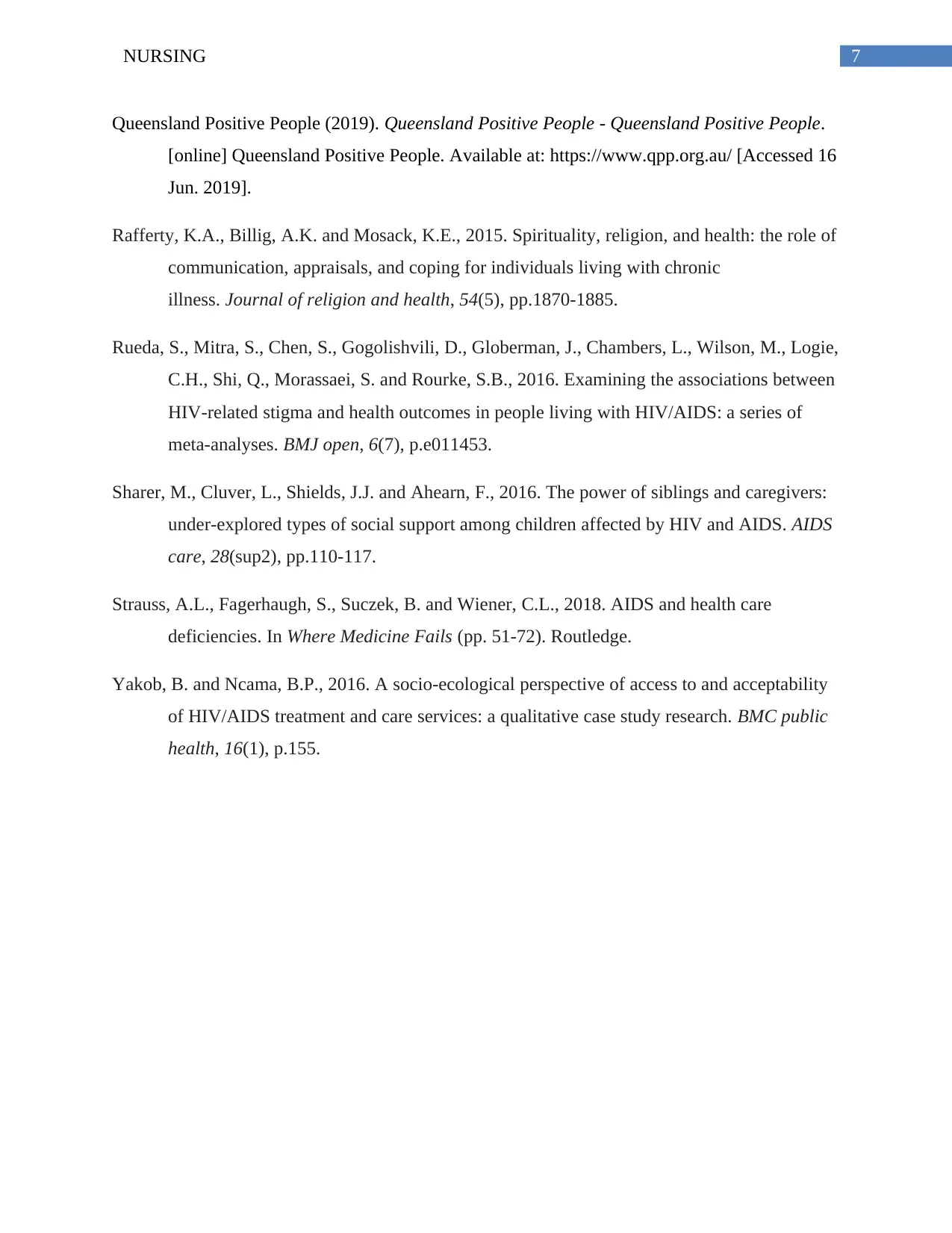
7NURSING
Queensland Positive People (2019). Queensland Positive People - Queensland Positive People.
[online] Queensland Positive People. Available at: https://www.qpp.org.au/ [Accessed 16
Jun. 2019].
Rafferty, K.A., Billig, A.K. and Mosack, K.E., 2015. Spirituality, religion, and health: the role of
communication, appraisals, and coping for individuals living with chronic
illness. Journal of religion and health, 54(5), pp.1870-1885.
Rueda, S., Mitra, S., Chen, S., Gogolishvili, D., Globerman, J., Chambers, L., Wilson, M., Logie,
C.H., Shi, Q., Morassaei, S. and Rourke, S.B., 2016. Examining the associations between
HIV-related stigma and health outcomes in people living with HIV/AIDS: a series of
meta-analyses. BMJ open, 6(7), p.e011453.
Sharer, M., Cluver, L., Shields, J.J. and Ahearn, F., 2016. The power of siblings and caregivers:
under-explored types of social support among children affected by HIV and AIDS. AIDS
care, 28(sup2), pp.110-117.
Strauss, A.L., Fagerhaugh, S., Suczek, B. and Wiener, C.L., 2018. AIDS and health care
deficiencies. In Where Medicine Fails (pp. 51-72). Routledge.
Yakob, B. and Ncama, B.P., 2016. A socio-ecological perspective of access to and acceptability
of HIV/AIDS treatment and care services: a qualitative case study research. BMC public
health, 16(1), p.155.
Queensland Positive People (2019). Queensland Positive People - Queensland Positive People.
[online] Queensland Positive People. Available at: https://www.qpp.org.au/ [Accessed 16
Jun. 2019].
Rafferty, K.A., Billig, A.K. and Mosack, K.E., 2015. Spirituality, religion, and health: the role of
communication, appraisals, and coping for individuals living with chronic
illness. Journal of religion and health, 54(5), pp.1870-1885.
Rueda, S., Mitra, S., Chen, S., Gogolishvili, D., Globerman, J., Chambers, L., Wilson, M., Logie,
C.H., Shi, Q., Morassaei, S. and Rourke, S.B., 2016. Examining the associations between
HIV-related stigma and health outcomes in people living with HIV/AIDS: a series of
meta-analyses. BMJ open, 6(7), p.e011453.
Sharer, M., Cluver, L., Shields, J.J. and Ahearn, F., 2016. The power of siblings and caregivers:
under-explored types of social support among children affected by HIV and AIDS. AIDS
care, 28(sup2), pp.110-117.
Strauss, A.L., Fagerhaugh, S., Suczek, B. and Wiener, C.L., 2018. AIDS and health care
deficiencies. In Where Medicine Fails (pp. 51-72). Routledge.
Yakob, B. and Ncama, B.P., 2016. A socio-ecological perspective of access to and acceptability
of HIV/AIDS treatment and care services: a qualitative case study research. BMC public
health, 16(1), p.155.
1 out of 8
Related Documents
Your All-in-One AI-Powered Toolkit for Academic Success.
+13062052269
info@desklib.com
Available 24*7 on WhatsApp / Email
![[object Object]](/_next/static/media/star-bottom.7253800d.svg)
Unlock your academic potential
Copyright © 2020–2025 A2Z Services. All Rights Reserved. Developed and managed by ZUCOL.





